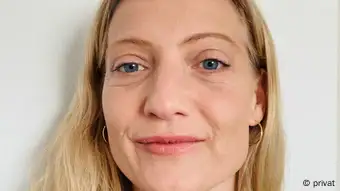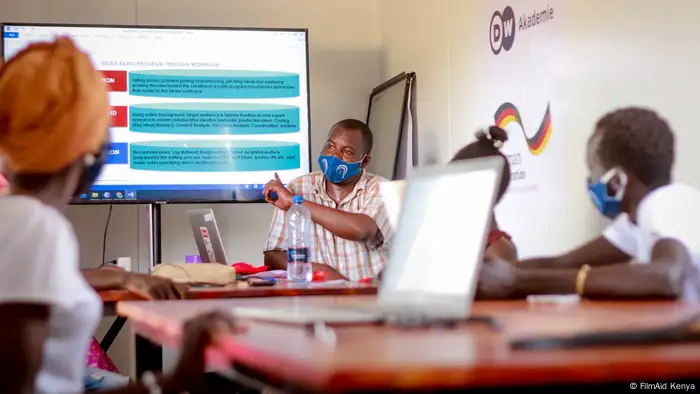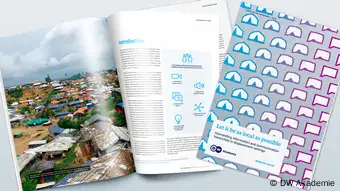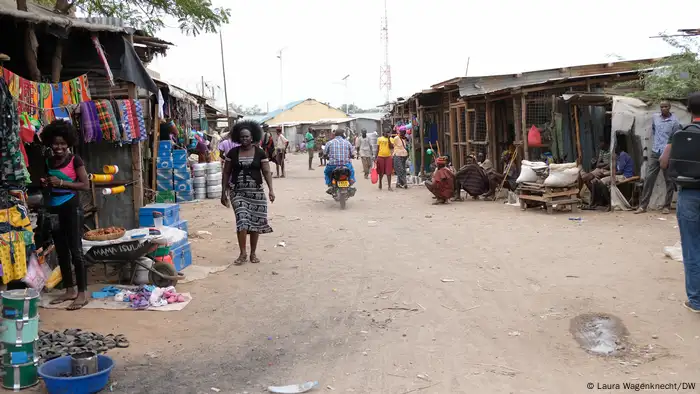Regions
Interview with Hannah Murphy: More than messaging
In a report published by DW Akademie humanitarian expert Hannah Murphy gives eight recommendations for communication in displacement settings. Media development could be crucial for participation and inclusion, she says.
DW Akademie: Hannah, you have written a report for DW Akademie titled, “Let it be as local as possible. Dismantling information and communication hierarchies in displacement settings”. Why did you want to tackle this topic?

Humanitarian advocacy and communication expert Hannah Murphy, conducted an online survey and interviewed 15 practitioners from DW Akademie and other organizations
Hannah Murphy: There's a lot of rhetoric about participation and inclusion in the humanitarian communication space. But in practice, I think, action has stagnated. It's not an area that is particularly well-funded, but it is critical to humanitarian response and development efforts. Large and small organizations are transferring their communication and information hierarchies into contexts where, unintentionally, they're creating barriers that prevent people impacted by displacement from communicating and contributing to service provision and solutions, from interrogating assistance, expressing their own ideas and talking about their experiences.
If most actors agree that it is necessary to shift to participatory communication in displacement settings, why is the corresponding action still stagnating?
I think there have been a lot of dramatic and positive changes in the area of feedback. Tools, processes and systems have evolved so people can participate in some form of decision-making relating to assistance in displacement contexts. However, evidence shows people in camp settings or different forms of temporary accommodation still struggle to access information about available services. And one reason is communication hierarchies are getting in the way. Of course, we may be talking about how the verification and careful dissemination of sensitive information can cause huge distress. In camp settings, if an organization gets anything wrong about the provision of services or specific groups having access to them, it's hugely problematic. So, there need to be controls and checks. But there is a huge problem about who has the authority to sign off on information and who has the authority to communicate. The processes of checking and verifying that information is causing delays and information gaps. In many cases, national staff are not empowered to communicate. In addition, service providers have to contend with misinformation and harmful rumors that need addressing systematically and more resources need to be allocated to this area.

"Sikika" – the Kiswahili word for "to be heard" – is a DW Akademie and FilmAid project in Kenya's Kakuma refugee camp and Kalobeyei integrated settlement. Young residents are trained in producing audio content, which is then made available to the communities via listening groups
What could to be done to improve the situation?
I think there needs to be a stronger evidence base. Further research could highlight the information gaps, delays and lack of communication opportunities for people affected by displacement. That evidence needs to be put forward to secure funding for projects that provide people with the training, tools and resources to have a much bigger role in the greater information and communication systems within humanitarian action. I think we need to start breaking down what words like “inclusion” and “participation” actually mean in practice. Another key area is data gathering and sharing, data protection and security. There's huge opportunity to think further about more effective collaboration and coordination in this space. One person I spoke to who is running a misinformation management project in a camp said: we have so much important feedback, but we have no way of sharing it. Where do we put it? Where does it go? I think media development organizations can play a much greater role in this space.
After talking to so many people who work on communication in displacement settings, what is your main takeaway?
Communication is still underfunded and undervalued as a pillar of any development process or humanitarian response. People working in the humanitarian context tend to perceive communication and media very narrowly as a means to broadcast messaging and provide public information. Communication is still not treated as dynamic process and practice, a reciprocal exchange to facilitate action, interaction, relationships and connections. We need to reconceptualize communication and media in an expansive and inclusive way so that we can better support people impacted by displacement.

In the report "Let it be local as possible", Hannah Murphy gives eight recommendations on issues like participation, coordination and research, and highlights projects that successfully use media to support equitable communication and information-sharing
Hannah Murphy is a former journalist and communication specialist working in displacement and other disaster contexts to design and create projects that ensure that people affected by disaster and facing barriers have the means and resources to access information and communicate their needs and perspectives, tackle misinformation and lead media development and other communication initiatives. She has worked with governments, inter-governmental and non-governmental organizations, focusing on advocacy, citizen engagement and external relations.
DW recommends
Downloads
- Date 05.04.2022
- Author Aarni Kuoppamäki, Laura Wagenknecht
- Feedback: Send us your feedback.
- Print Print this page
- Permalink https://p.dw.com/p/49Rty
- Date 05.04.2022
- Author Aarni Kuoppamäki, Laura Wagenknecht
- Send us your feedback.
- Print Print this page
- Permalink https://p.dw.com/p/49Rty

